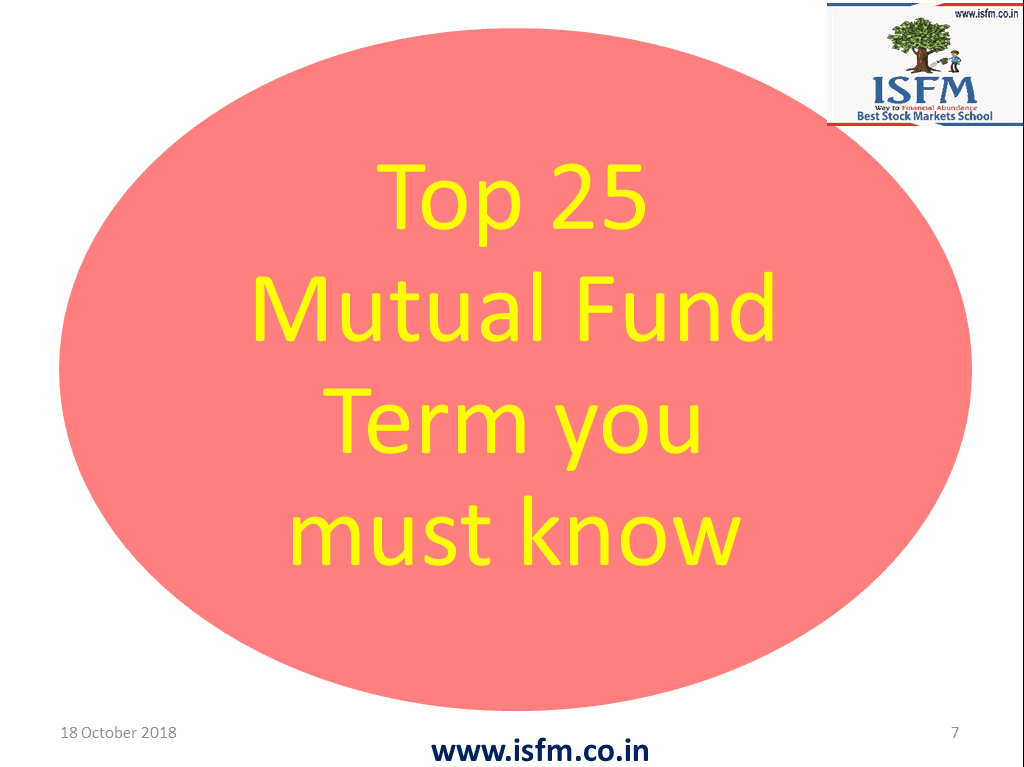Top 25 Mutual Fund terms you must know

Mutual Fund is a panacea for all the investors who don’t have the these top 3 investment traits :
- Don’t have enough fund to invest in stock market
- Don’t have enough time to study the market
- Don’t have enough knowledge to understand the market
Indian Mutual fund industry in growing very fast and as of now total 25 Trillion AUM having with 43 AMC from top 30 cities of India. Thanks to all doctor, engineers, lawyer’s, teachers and other professional due to their SIP, Mutual fund market is now 12.5% of the GDP. Although it is low as compare to the developed nation but it will cover all the deficiency very soon in future.
SEBI and AMFI is also doing endless efforts to make Mutual Fund transparent and easy but still now a common man is not able to understand pros and cons of the fund. So here ISFM – Stock Market training institute in Gurgaon trying to make easy to the Mutual fund terminology.

- Net Assets Value means unit price of the Mutual Fund. It can be calculated with total Assets / total no. of units
- AMC : Assets Management Company which manage the capital of the Investor. The role of the AMC is to manage investor’s money on a day to day basis. Thus it is imperative that people with the highest integrity are involved with this activity.
- AMFI:– All India Mutual Fund Association is a association of the mutual fund amc. It is not constitutional authority by its play a significant role to regulate the market apart from SEBI.
- ARN Holders : AMFI issue a unique number to every agent who want to sell the mutual fund in the market. First person have to clear NISM distributor certification then can approach to the AMFI.
- NFO :- New Fund offer by a mutual fund company to the investors. AMC launches new schemes, under the name of the Trust, after getting approval from the Trustees and SEBI. The launch of a new scheme is known as a New Fund Offer (NFO)
- Folio no. : Folio number like a bank a/c which is used to keep the mutual fund in electronic form.
- Offer Documents : Official detailed information about mutual fund given by sponsor. The investor must read the Offer Document (OD) before investing in a mutual fund scheme.
- KIM : Key information Memorandum is small document which provide snapshots of the important information to the investor in a brief view.
- Open Ended Fund :- open ended scheme allows the investor to enter and exit at his convenience, anytime except under certain conditions.
- Close Ended Fund : Close ended scheme don’t allow the investor to enter or exit any time but they give some lock in period to the investor.
- Total AUM :- How much fund manager have the total amount collected by all the investors in his scheme called AUM.
- Load : Load means Charges to entry or exit in mutual funds. There are two kind of charges
- Entry load : When u invest in Mutual fund then you have to pay some amount to the AMC but from 2009 itself it is free of cost in India.
- Exit load : When a investor sell the mutual fund the he have to pay few charges to the AMC called exit load. For example, Suppose you are selling a fund of 50000 Rs and exit load is 1% then you have to pay 500 rupees being a brokerage.
- Expenses Ratio : It is a Annual fee charge by fund master to the investor to manage the fund of the investor. Now a days SEBI is trying to reduce the fee from 2.5% which is maximum slab from 1% so that investors can get relief.
- Portfolio : – Where the fund master have investment the money of the investors. As per rule of the SEBI Mutual fund manager must have to show his portfolio to the public on his website so that investor can know where he has invested.
- Portfolio Turnover:- It is define as ‘Lesser of Assets bought or sold/ Net Assets’. A scheme with Rs. 200 cr as net assets sells Rs 40 cr of its investments. Thus its Portfolio Turnover Rate would be 40/ 200 = 20%. If this scheme’s net assets increase to Rs. 220 cr and the fund manager decides to churn the entire portfolio by exiting all stocks, then the Portfolio Turnover would be 220/ 220 = 100%
- CAGR : Compounding Annual Growth return of the Fund year on year, its showing actual growth of the fund in the market.
- Churning : How a fund manger can switch his portfolio from one securities to other securities time to time. Even there is no cap how many time a fund manager can switch but they generally use value investing strategy for investment.
- Rating of Mutual fund : How credit rating company giving him rating after checking his position in the market. Although now a days it is not a matter of proud for anyone
- Fund of Fund : When a investor invest his fund in a others mutual fund special to the foreign funds then it called fund of fund.
- ELSS Scheme : Equity Linked Savings Schemes (ELSS) are equity schemes, where investors get tax benefit upto Rs. 1.5 Lakh under section 80C of the Income Tax Act
- Redemption : When investor sell his mutual fund to the AMC not to the other investor called redemption. The redemption NAV would be the latest NAV of yesterday. 22. Indexation Benefits: Indexation is a procedure by which the investor can get benefit from the fact that inflation has eroded his returns. 23. LTCG on MF:Long term capital gain tax is applicable on mutual fund now a days, but it is free up to 1 lakh rupees within a financial year. If you are earning more than 1 lakh you have to 10% if you redeem. 24. CAN number: Common A/c number is a unique number provided by the MF utilities to invest in direct plan of mutual at one place. It is provided after opening a/c on mfuindia. We can bring all the investment under one roof.


